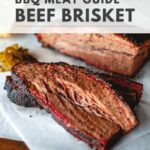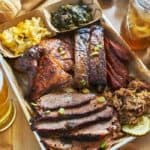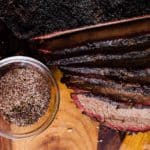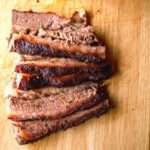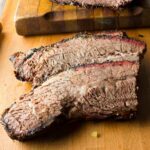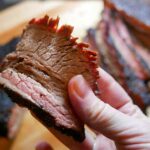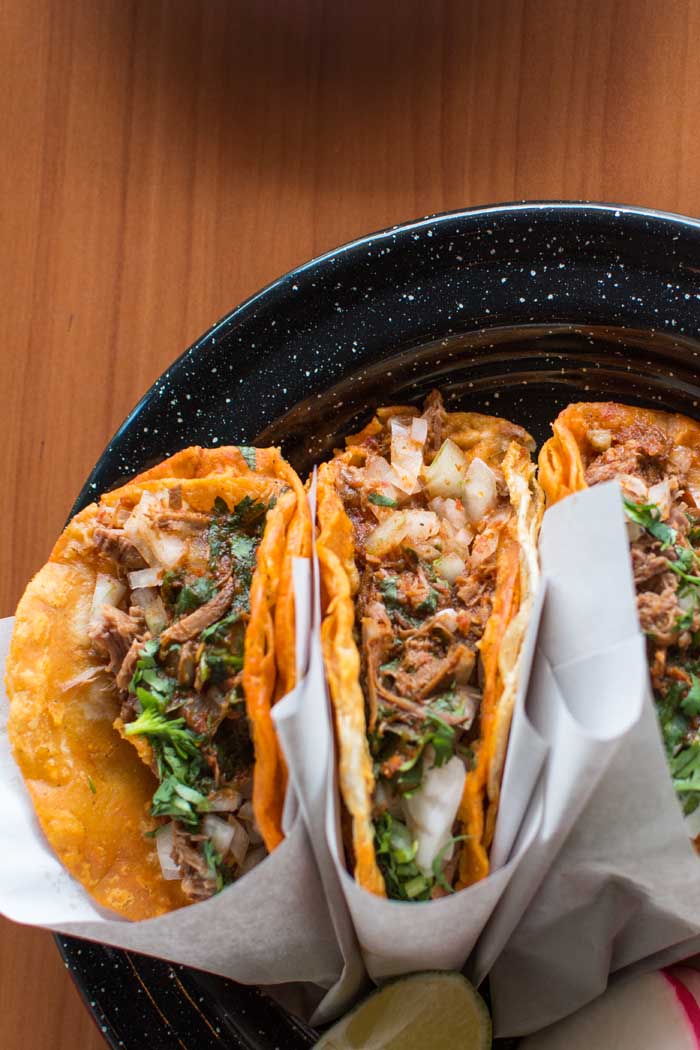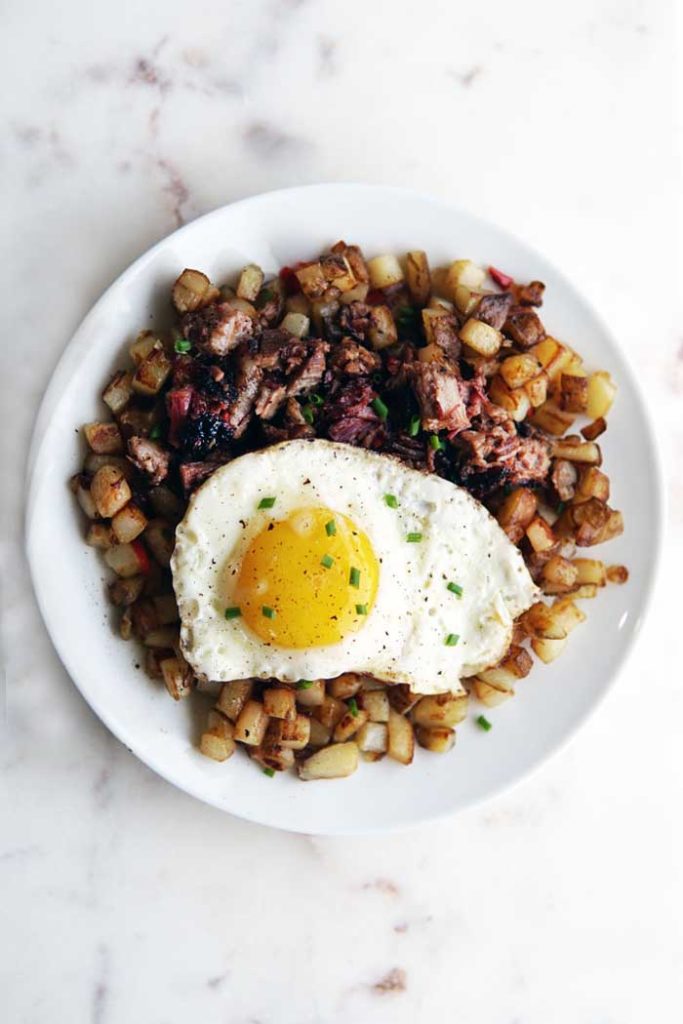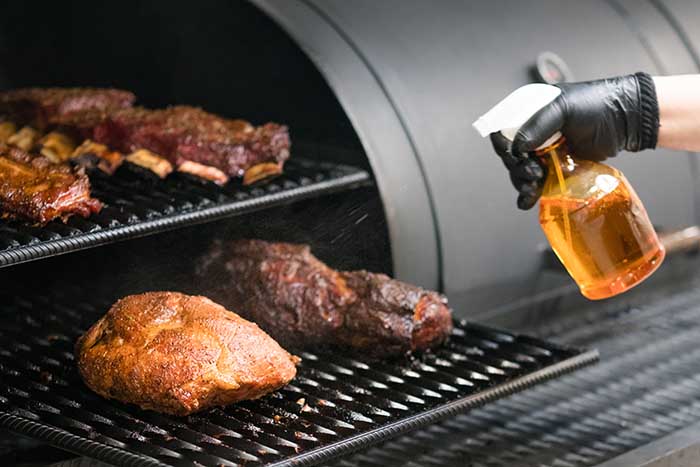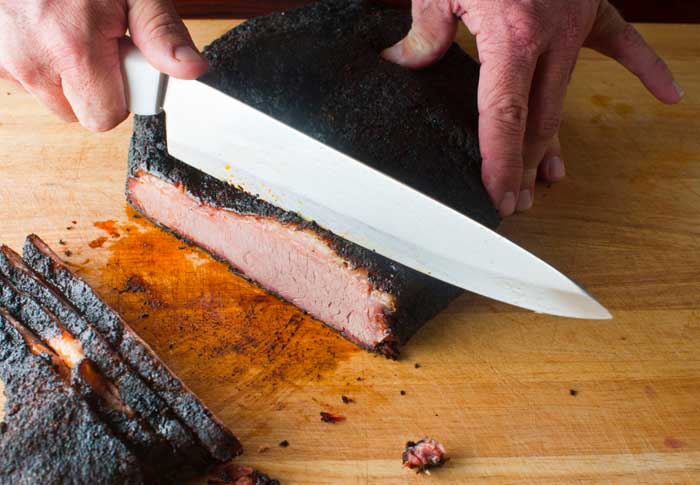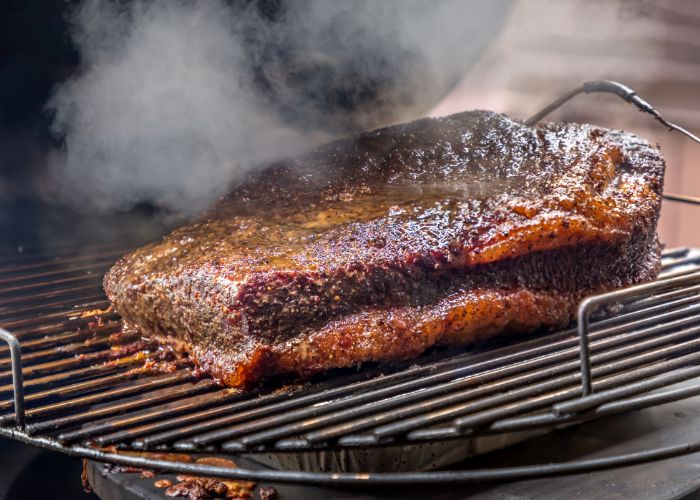Beef brisket is one of the best cuts of meat for barbecue. With a deep and intense flavor, it is made for smoking low and slow. Here’s everything you need about brisket.
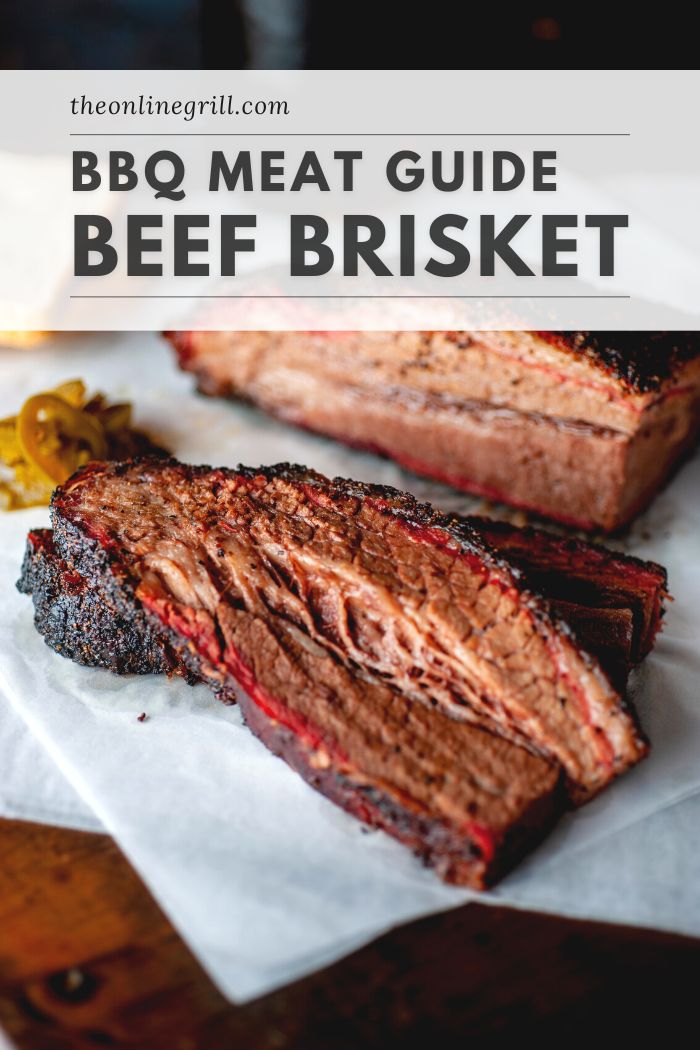
Beef brisket is the barbecue world’s most iconic meat cut thanks to its rich flavor and melt-in-your-mouth tenderness. Whether you enjoy it smoked Texas-style or chopped up for burnt ends, this famous beef cut is perfect for barbecue.
Dive into our comprehensive guide on everything you need to know about this remarkable cut of meat. Discover smart tips on buying, preparing, and BBQ smoking your brisket, along with exciting recipe ideas and tips.
This is everything you need to know about brisket.
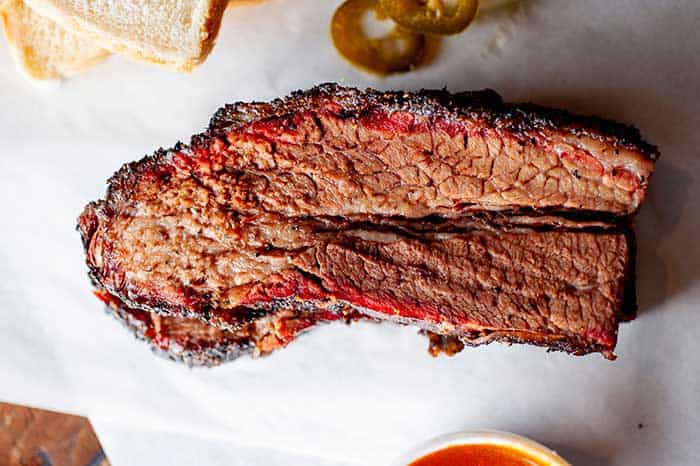
What is Brisket?
Brisket is a tough and unforgiving piece of meat that grows along the chest of the animal. While it’s one of the most difficult cuts to cook well, it’s also one of the most rewarding, and it’s a staple at BBQ joints throughout the country. So, what is brisket, exactly?
Two large muscles make up a full piece of brisket. The thicker muscle is known as the point while the thinner portion is known as the flat. The point features heavy marbling and lots of fat, while the flat is less fatty. In restaurants, the point is sometimes called “fatty brisket” while the flat is referred to as “lean.”
Both pieces are delicious, with a meaty flavor that takes on the smoke from the wood exceptionally well. Many BBQ lovers prefer the melt-in-your-mouth juiciness of a piece from the point. Of course, you’ll find just as many people who prefer the lower fat content and firmer texture of flat brisket. It’s all a matter of preference.
At the grocery store, you’ll come across small pieces of brisket under five pounds that have the lion’s share of the fat trimmed away before packing. This grocery store cut is almost always the flat portion of the brisket.
There are plenty of ways to cook a smaller, leaner brisket, but if you’re looking for the full barbecue brisket experience, you’ll need to head to your local butcher for a packer brisket, which is usually in the realm of 10-15 pounds.
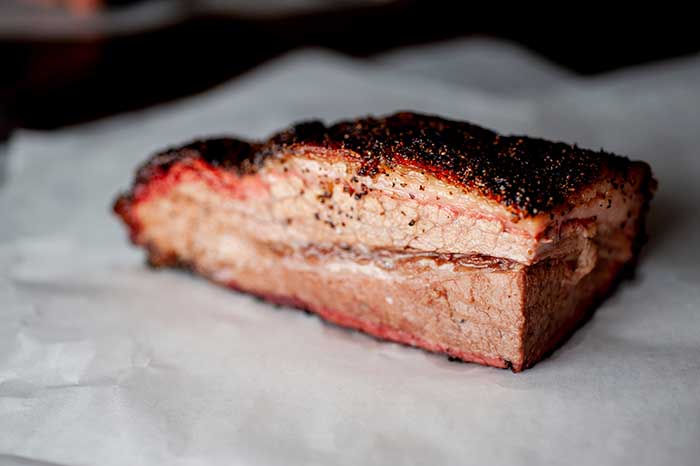
What Part of the Cow Is Brisket?
The brisket is the pectoral muscles of the cow, and they run along the animal’s chest. Cows rely on these muscles for virtually all physical activity. These muscles are used in walking, running, standing, and anything else that involves moving.
Since the cow uses these muscles so often, the meat is exceptionally tough, and it’s also full of sinewy connective tissue. If you were to slice brisket and cook it like a steak, it would be like eating shoe leather. But, the cut is tailor-made for cooking low and slow in your smoker.
The low temperature and smoke combine to tenderize the meat, breaking down those sinewy tissues and locking in an unmistakably rich and beefy flavor that brisket is so loved for.
Before you set out for your first smoke, you’ll want to understand the different parts of the brisket.
Flat
The brisket flat, which is sometimes called the “first cut,” is the leaner of the two muscles that make up a brisket. The flat is connected to the cow by a layer of fat and tissue known as the deckle. Once the deckle is removed, the flat can lie, well, flat, which explains its namesake.
The flat has a firm texture with less marbling, and it’s not as moist or delicate as the meat from the point end of the brisket. Compared to the point, the flat is much larger and thinner, and its slices hold together perfectly, which makes the flat ideal for a brisket platter.
Point
The point is the second muscle of the brisket, and it’s quite different from the flat portion. The point is the smaller of the two cuts, but it’s significantly thicker. This cut is characterized by a thick layer of fat on top of the meat and generous fat marbling throughout.
Compared to the flat, the point is much juicier, with more fat. Since the meat is so well-marbled, and the fat melts during cooking, brisket from the point doesn’t have the attractive uniformity that a slice from the flat does. Keep in mind, you’re choosing a piece of meat, not a prom date. While it might not look as pretty, most barbecue lovers will tell you that they prefer the point.
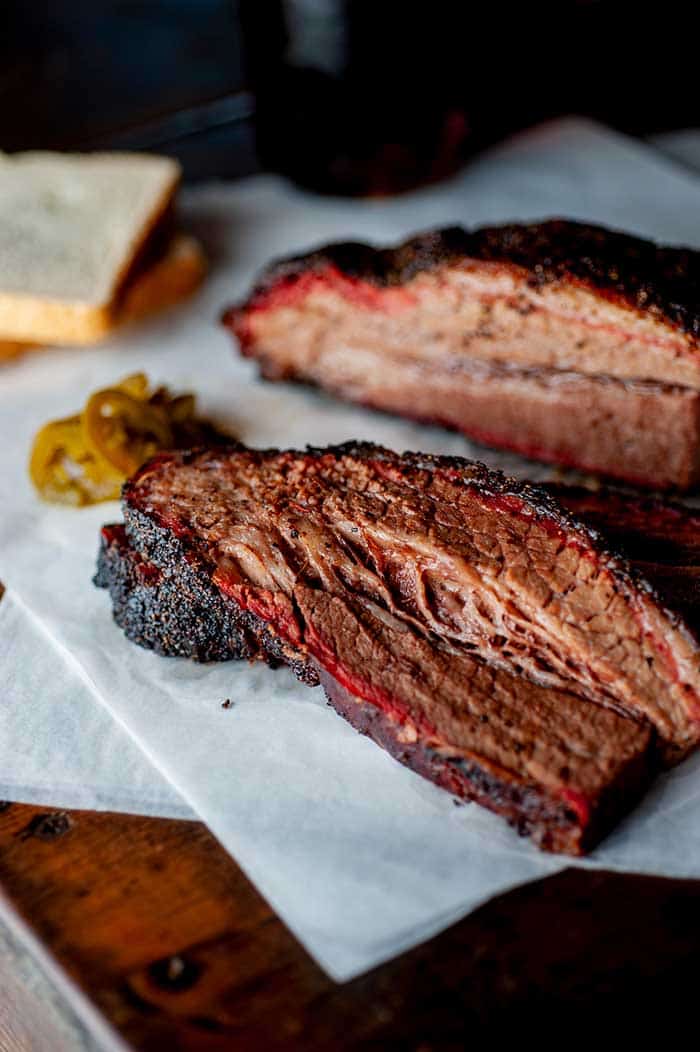
Deckle
In some circles, the deckle is just another name for the point. That’s a bit of a misnomer.
The deckle is a large piece of hard fat and muscle tissue that connects the cow’s pectoral muscles to its rib cage. Unlike the soft fat that will render out during cooking and impart the brisket with richness and flavor, the deckle is harder, and it won’t render out during cooking, so it’s best to remove it.
The deckle is immediately recognizable as a thick piece of fat attached to the point end of the brisket. Using a small knife, cut down into the deckle and begin to lift it away from the brisket below. There’s typically a small membrane you’ll want to follow with your knife to remove.
Once you remove that membrane, slice into the deckle and begin to pull that back from the brisket. Gently follow it with your knife as you pull the deckle away from the meat. Once you begin to see the bright red meat below, use your knife to follow along the bottom of the deckle to remove it completely.
If you’re having difficulty locating the deckle on your brisket, that might be because it isn’t there in the first place. Some butchers will remove the deckle before packaging the brisket, although it’s typically left on a packer brisket. If you see a deep cut into the point area of the brisket, this is a dead giveaway that the deckle has already been removed.
Fat Cap
The fat cap is a thick layer of fat that surrounds the point of the brisket, and it holds the key to a delicious and juicy piece of meat. Before cooking, you’ll want to remove most of the fat cap, leaving behind a thin layer of fat that will help keep the brisket moist and protect it during cooking.
To remove the fat cap, start with an ice-cold brisket. Removing the fat is much easier and safer to do when the brisket is cold. Start by carefully trimming down the fat cap with a sharp knife, taking care to leave at least ⅛” of fat intact on the meat.
How much fat to leave behind is a matter of preference. Most BBQ chefs elect to leave behind ⅛” and ¼” of fat on their brisket. Some choose to score the remaining fat on the brisket, while others will leave strategic “windows” of meat where they completely remove the fat. These windows allow the brisket to absorb the seasonings and rendered fat as it cooks.
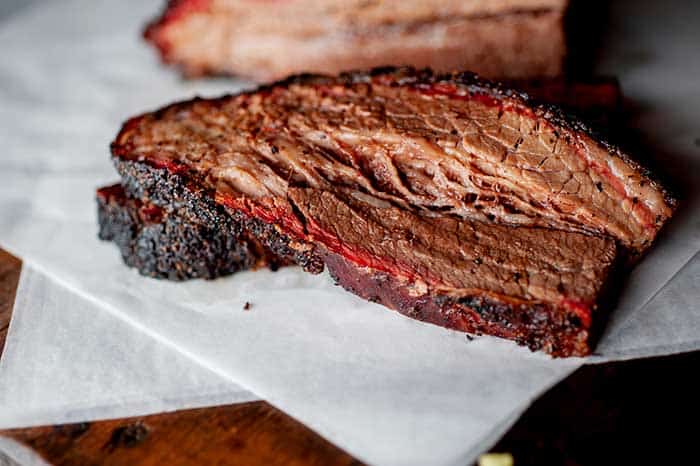
How to Buy Brisket
Brisket has grown in popularity, so it’s easier to find than ever before. However, that doesn’t mean that every meat purveyor sells the type of brisket you’ll need for your cook.
You can easily find a flat at virtually every supermarket, but if you’re interested in smoking a whole brisket, you’ll need a packer brisket. Warehouse clubs like Sam’s Club, Costco, or BJ’s typically have a solid selection of packer briskets. But, your best bet is to head to your local butcher.
Your butcher will be able to provide advice, show you the basics, and send you off with an ideal piece of meat. Local butchers also tend to take a bit more pride in preparation and packaging than a national store.
For a packer brisket, expect it to be in the realm of 10-15 pounds. Depending on where you are, the season, and the brisket grade, you can expect to pay between $3-8 a pound for brisket.
Best Ways to Smoke Brisket
You’ll hear all sorts of different answers on the best way to smoke a brisket. While the best advice is to smoke it however you like to eat it, there are some specifics that make for a better finished product!
Most barbecue fanatics like to smoke their brisket whole, as this preparation produces the richest, moistest, and most flavorful meat.
For the sake of time, many people prefer to prepare a whole flat, which takes about half as much time to cook and produces beautiful, uniform slices.
Another popular preparation that’s preferred by Kansas City-style BBQ enthusiasts is burnt ends. To prepare burnt ends, start with the whole point end of a brisket. Once the internal temperature has reached 165 degrees, the meat is cut into cubes, placed into a large pan or tray, and sauced before being returned to the smoker for another hour or two so the meat can absorb more smoke and sauce.
Time and Temperature
Most BBQ cooks like to smoke their brisket at 225 degrees, which seems to be the sweet spot for producing a gorgeous-looking and tasty brisket. At 225 degrees, the rule of thumb is to cook your brisket for 1½ hours per pound. Depending on the brisket’s size, you can expect it to take 10-14 hours for your brisket to cook.
You’ll want to smoke your brisket until it’s reached an internal temperature of 195-200 degrees. A brisket’s temperature can increase by up to ten degrees after you pull it from the smoker, so it’s best to pull your meat a few minutes early.
How to Store Brisket
Once you’ve brought home your brisket, it will stay in your freezer for three to five days after purchase. Don’t remove it from its original packaging until you’re ready to cook. If you choose to freeze your brisket, it will stay for 6-12 months or longer. You can maximize its shelf life in the freezer by wrapping the package in aluminum foil or plastic wrap, then placing it inside a freezer bag.
